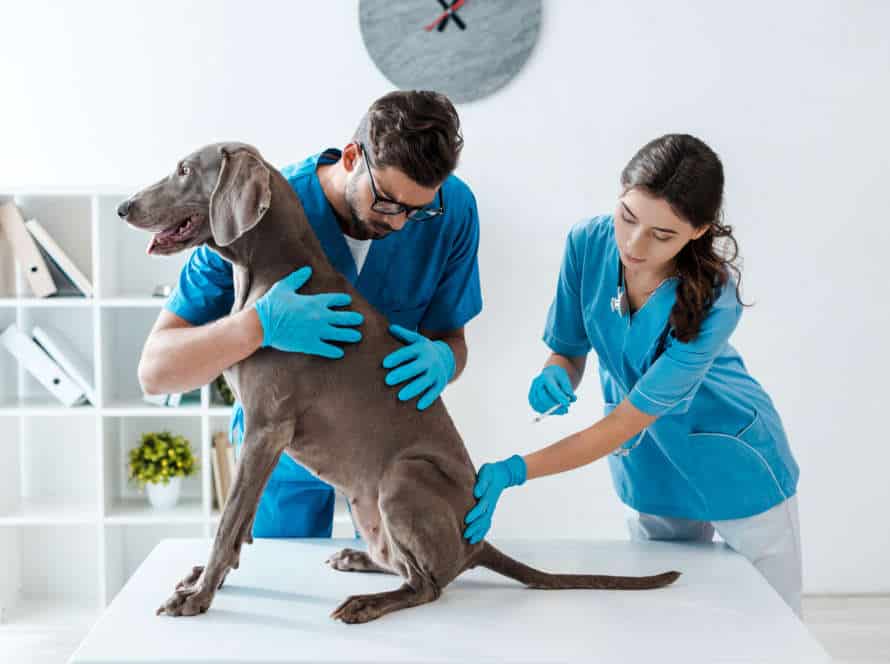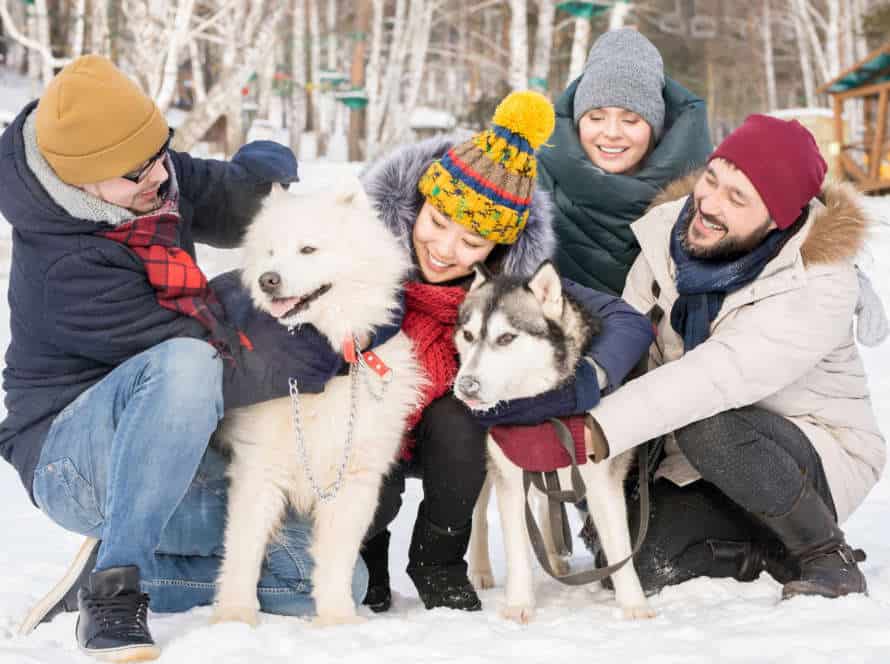What to Do If Your Dog Goes Missing
Losing a pup can be frightening for any pet parent. It’s essential to act quickly and systematically to find your furry friend. Here’s what you should do:
- Look around your house, backyard, and nearby areas. Yell your pup’s name or shake a bag of treats.
- Contact local animal control and verified shelters to report your missing dog.
- Create a lost dog poster with a clear photo, description, and contact info. Share it on social media, groups, and bulletin boards.
- Place your pup’s favorite blanket, toy, or food bowl outside your house.
- Have a search party with family & friends. Search the neighborhood and nearby parks.
Remember: Act fast and spread the word widely and quickly. Your pup’s safe return is worth the effort.
Pro tip: Get your pup microchipped. Ensure their contact info is up-to-date. This will increase the chances of them being reunited with you if they go missing in the future.
Immediate Actions to Take
If your pup disappears, you must act fast to find them. Be prepared with a plan, just in case. Follow the steps below for the best chance of getting your doggie back.
- Post signs
- Contact animal shelters
- Alert neighbors
- Get online
- Spread the word
Check your house and the surrounding areas
Losing your pet can be a scary and stressful time. Start by searching your home and the surrounding area to see if your dog has hidden or wandered off.
Check every room and any places your dog might hide, like closets or under furniture.
Take a walk calling out your pup’s name and using familiar sounds to get their attention.
Check with neighbors for any info that could help.
Look up animal control and shelters to see if someone found your pup.
Pro Tip: Keep your dog safe by giving them ID tags and a microchip. When outside, make sure they are on-leash or in a secure location.
Search the neighborhood and put up posters
If your pup is missing, searching the area and creating posters are must-do steps. Here are some tips for success:
- Ask folks like your neighbors, mailman, and any people you see if they saw your pup. Describe them in detail.
- Put up posters in areas with lots of people, such as parks, playgrounds, and shopping centers. Include a picture of your pup, contact details and other info.
- Take to social media and pet recovery sites like Finding Rover or Pet FBI.
- Call local pet rescue, animal control, and vets to see if your pup is there.
- Offer a reward for their safe return. Be careful of any ransom requests.
Time is important when searching for your pup. Act fast and keep looking until you find them!
Contact animal shelters and vet clinics
If your pup is lost, contact your nearby pet shelters and vet clinics. Why? Animal shelters usually have a ‘lost and found’ data base. They can find if your dog was taken in. Vet clinics may also have info on pooches in the area and they can recognize your dog if someone brings them in. When getting in touch, provide a recent photo, their name, breed, age and any unique features. Leave contact info so they can reach you if your pup is found. Time is essential when searching for a missing dog, find out other steps you can take to locate your furry friend.
Use Online Resources to Aid Your Search
Losing your furry companion can be scary and overwhelming. Act fast and make use of the internet to help you search. There are many online options to help you find your pup. Such as social media and websites specifically designed to locate lost pets. Let’s explore the different resources available to you.
Post on Lost & Found Pet Facebook Groups
Lost & Found Pet Facebook groups can be great for when your pup goes missing. Here’s how to post & increase chances of finding your pooch:
- Post a clear pic & any special features like tags or markings.
- Describe your pup – breed, size, any quirky behaviours or medical conditions.
- Include date & location of last sighting, plus other details.
- Put your contact info & ask people to report sightings or leads directly to you.
Check the group & reply to comments/messages. Update if your pet is found or there are developments in the search. Don’t give up!
Pro tip: As well as Facebook groups, contact local animal shelters, vets & police stations about your pet.
Use LostMyDoggie.com to create a flyer and search for lost pets
Has your pet gone missing? You can use LostMyDoggie.com to make a flyer and look for them quickly. It’s easy to use!
You can make a poster with your pet’s photo, description and contact info.
LostMyDoggie.com will tell local shelters and vets about your missing pet, so more people know. It can even help you search in areas farther away. Plus, it has resources to help you with your search.
Don’t forget to check shelters and vet offices near you, as well as social media and community groups.
Pro tip: Keep your pet’s ID tags updated and get them microchipped – it could bring them home safe!
Utilize Missing Animal Response Network (MARN) for additional support
If your pup has gone missing, MARN is a great online resource to find them.
- Visit the MARN website and sign up.
- Get the lost pet recovery kit from MARN, and generate flyers, posters, and search strategies.
- MARN has a database of pet detectives, search teams, and K9 handlers to help look for your pet.
- Join the MARN online community for support, tips, and advice.
- Don’t forget to contact local animal control, shelters, and vet clinics to tell them about your missing pet.
Contact Relevant Local & National Organizations
If your pet is missing, contact local and national organizations. These can help you find your pooch fast! Local authorities, shelters, and rescue groups are all great resources. Act quickly – it’s key. The sooner you reach out, the greater your chances are of finding your dog. Let’s discuss how to best contact these important parties.
Contact your local animal control agency
If your pup has vanished, one of the chief things you should do is reach out to your local animal control agency, as well as other local and national organizations, to increase your chances of finding your four-legged friend! Here are some steps:
- Local Animal Control Agency: Get in touch with your local animal control agency. They’ll help notify other animal shelters in your area and keep track of lost and found pets.
- Local Vet Clinics: Call the nearby vet clinics in your area. They might know if someone has brought a lost dog matching your pet’s description or if they’ve been injured and need medical aid.
- Social Media Platforms: Post a pic and info about your lost dog on social media, like Facebook, Instagram and Twitter.
- National and Local Lost and Found Pet Databases: Use national and local databases that help pet owners find their lost pets.
Pro Tip: Make sure your doggo wears an ID tag or has a microchip with up-to-date contact info at all times. In case they go missing.
Contact the American Kennel Club (AKC)
Lost your dog? First step: contact the American Kennel Club (AKC)! Call (919) 233-9767 or submit a form online. Also alert their network of volunteers.
Local animal shelters? Contact them & ask if they’ve seen your pet.
Reach out to local Animal Control & file a lost pet report.
Online resources like LostMyDoggie.com, PawBoost.com & HelpingLostPets.com can help too.
Taking quick action increases chances of finding your beloved pet. Pro Tip: Microchip & collar your dog with ID tags – makes it easier to identify & reunite!
Contact Pet FBI or Finding Rover to report the lost dog
Losing a dog is stressful. For best chances of finding your pet, contact local & national organizations. Pet FBI & Finding Rover are two helpful resources.
Pet FBI is a non-profit organization that offers online resources & support groups to help reunite lost pets with their owners. Contact them for alerts & guidance.
Finding Rover is a free app that uses facial recognition tech to match photos of lost dogs. Report your lost dog on the app & increase its visibility to others.
Don’t forget to contact local animal shelters, vet clinics & community groups too! They may be able to help.
Tips to Prevent a Lost Dog
Losing a pet can be traumatic. It’s heartbreaking. But, you can take steps to stop your pup running away. Keep your pup on a leash when you’re out. This is the best way to make sure they stay close. Give them an ID tag too. It should have your contact info in case they wander off. There’re more steps you can take. Let’s check them out.
- Keep your yard/garden enclosed; make sure all gates are locked and fences are secure.
- Monitor your dog when they are in the yard/garden; don’t leave them unattended.
- Train your dog to respond to your commands; obedience training can help prevent runaway behavior.
- Microchip your dog; this provides an additional means of identification if your dog becomes lost.
- Consider spaying or neutering your dog; dogs that are fixed are less likely to roam.
Microchipping and registering your dog
Microchipping and registering your pup is a must to stop them from straying and increase the chances of them being found quickly and safely. Here are some tips:
- Microchip your pooch! This tiny, grain-sized device, implanted under their skin, gives them a unique ID number. It can be read with a scanner, and it’s a permanent way to identify them.
- Register the chip: Use a reliable database to link your contact info to the chip number so you’ll be notified if they’re found.
- Keep contact info updated: If you move or get a new number, update the chip registration.
- Dog tags: Attach tags to their leash with your phone number and other details. This can help someone return them.
- Have updated photos: Keep photos of your dog on your phone and print them for posters. People will recognize them and return them.
Remember, prevention is key! Do whatever you can to keep your furry friend safe.
Training your dog to respond to commands
Training your pup to obey orders is key to avoid them getting lost. Here’s how:
- Be consistent – use the same commands & reward system each time.
- Keep it positive – praise & rewards (treats, toys, extra playtime) work better than punishment.
- Begin with basic commands – e.g. “sit,” “stay,” “come,” & “heel“.
- Train in small increments – start with short sessions & increase complexity of commands over time.
- Focus on recall – practicing the “come” command is essential to stop them running off & getting lost.
Also, even a well-trained dog can wander off, so make sure they have proper ID tags & microchipping. If they do get lost, contact local animal control centers, vets & neighbours, & spread the news on social media.
Making sure your dog has proper identification tags
Having the right ID tags on your pup is key to keeping them safe and making sure they don’t get lost. Here are tips for proper tags:
- Put your pup’s name, phone number, and address on the tag.
- Make sure the tags are fastened securely to the collar.
- Buy tags that are hard-wearing and last.
- Check tags regularly to be sure they are still legible and details are current.
- Microchipping your dog is a great option for extra ID.
If your pup goes missing, take action fast! Contact animal shelters, post flyers in your area and inform the community through social media. Time is of the essence when looking for a lost pup, so be quick and never give up.
Frequently Asked Questions
1. What should I do first if my dog goes missing?
The first thing to do is to search your neighborhood and surrounding areas immediately. Check with any nearby animal shelters, veterinary clinics, and dog pounds. Spread the news of your dog’s disappearance as much as possible among your family, friends, and neighbors.
2. Should I contact the police if my dog goes missing?
No, you don’t have to contact the police, but it’s a good idea to notify them in case someone reports a found dog or another incident related to your missing pet. You can also file a lost pet report with animal control.
3. What should I do if someone finds my dog?
Make sure that your dog is safe and healthy; then thank the person who found him and take him home as soon as possible. Make sure to spread the good news among your family, friends, and neighbors that your dog is home and safe.
4. How can I prevent my dog from going missing in the future?
There are several things you can do to prevent your dog from going missing: micro-chipping your dog, using a dog collar with identification tag, keeping your dog on a leash or confined in a gated area or enclosure, securing your yard and entrances to your home, and training your dog not to run away.
5. How long can I expect my dog to survive if he goes missing?
The survival time for a lost dog depends on several factors, such as the location of the dog, the weather conditions, and the dog’s health and age. However, most lost dogs are found within the first 72 hours.
6. What should I do if my dog never returns home?
If your dog is still missing after a few days, keep searching the area, distribute flyers and posters of your missing dog, and post on social media about your missing pet. You can also offer a reward for his safe return. Consider hiring a pet detective or a professional search and rescue team to help you find your lost pet.







